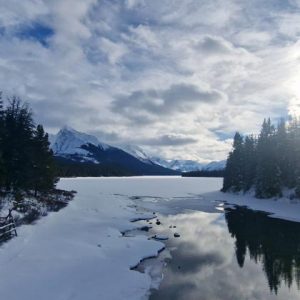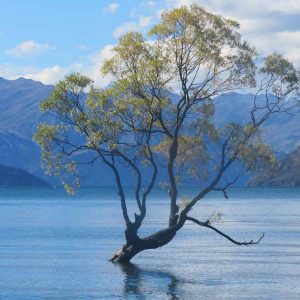‘Hola! Vino blanco aqui’ yelled the scruffy old man, a little distance from our stony path. We almost ignored him, but it was a glorious day and we were in no rush.
‘Aqui, aqui’, he repeated, as we followed him through a narrow doorway in the crumbling stone wall into an allotment-like garden, baked dry with sun and wind.
‘Por favor’, he waved, inviting us to sit down on rickety stools set against an al fresco bar counter, complete with granite counter-top.
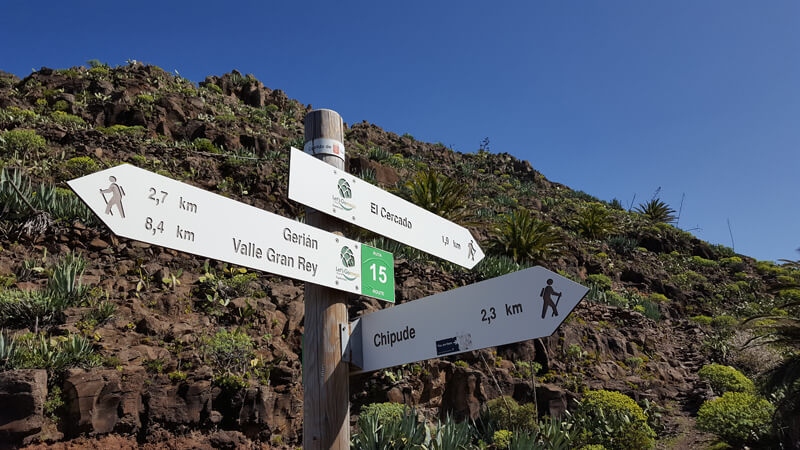 He uncorked the distinctly pee-coloured wine, and poured us a couple of glasses, pointing to the almost invisible twisted vines peeking out from the arid soil. ‘Make wine September, October.’
He uncorked the distinctly pee-coloured wine, and poured us a couple of glasses, pointing to the almost invisible twisted vines peeking out from the arid soil. ‘Make wine September, October.’
The wine tasted better than it looked.
I asked his name.
‘Placido‘.
‘Like the singer? Domingo?’.
He laughed. ‘Si. Chorizo?’.
‘Gracias, no’. I tried to explain that we had just eaten our picnic, on a verdant slope not far below the highest point on La Gomera, in the Garajonay National Park.
‘Vino tinto?’. And off he limped to a ramshackle house, returning with a decanter of ruby liquid and a couple of brandy glasses. ‘Con hierbas’, he said, waving again at the garden. ‘Fuerte‘. And it did taste strong, and a little sweet. We both preferred it to the white.
‘Buy bottle. Small bottle’, he urged.
‘Gracias, no’, I said again, a little reluctantly but without the Spanish to say that we were already right up against our luggage limit. But even with the language challenge, we managed to understand from Placido that there is much poverty in La Gomera, and that many of the island’s young people emigrate to Venezuela, Cuba or Italy, or make the short hop across the water to Tenerife, for work and a decent life.
We eventually said adios to Placido, after he had demonstrated the traditional ‘Silbo Gomero‘ whistling language, cupping a hand to his leathery face, and telling his neighbour across the valley that the vino blanco bottle was open. We said muchas gracias, and repaid him with what was hopefully a generous contribution for the wine and his hospitality, and by steering a couple of German walkers into his cultural garden bar.
My wife Gill had visited La Gomera, the second smallest Canary Island, almost 30 years ago. She had happy memories of its quiet, understated charm and had always wanted to return. So, on a February day when the UK would benefit from record temperatures – ironically thanks to warm winds blowing up from the Canaries – we landed to explore the island on foot, on a self-guided holiday with Macs Adventure.
La Gomera is volcanic, only 14 miles from one coast to another, extremely mountainous and looks to me like a brain, thanks to the plunging ravines – barrancos – cleaving deep gaps between the peaks, right down to the sea. Gill had driven around the island before, on narrow gravel tracks definitely not for the faint-hearted. New and wider tarmac roads have now been built, but thanks to the island’s geology it takes an inordinate time to reach somewhere close on the map.
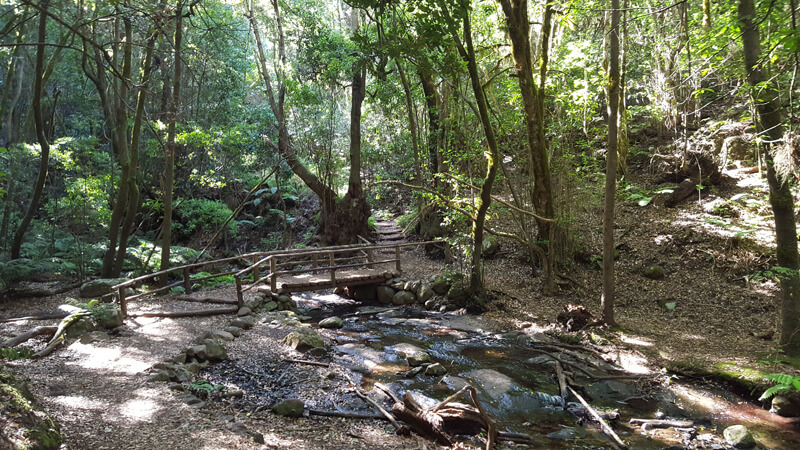 Far better to see La Gomera on foot, and the Macs Adventure 6-day walking route gives you a much more intimate feel for the varied landscape.
Far better to see La Gomera on foot, and the Macs Adventure 6-day walking route gives you a much more intimate feel for the varied landscape.
Start off in the dense, lush rain-forest at the heart of the island, climbing up through ancient laurel woods. The views expand as you go deeper – and higher – into the Garajonay National Park, the jewel in the island’s natural crown and a UNESCO World Heritage Centre. Here, you’ll hopefully be able to glimpse the conical peak of Mount Teide – the 3,718m peak of neighbouring Tenerife – usually peeking through a girdle of lower cloud. Traverse barrancos to quiet villages, descend to the coast through terraced fields and palm groves, catch enticing scents of juniper and eucalyptus, and take a brief breather on beaches with blackened sand and rocks.
Stay in charming, simple family-owned rural hotels in the small towns of Chipude, Vallehermoso and Hermigua, book-ended by nights in the relative grandeur of the 4* Parador in the capital San Sebastian, with its attractive pastel-painted houses, perched high above the port ferrying you to and from Tenerife.
Along the way, you’ll get to know Gomeran cuisine: almogrote, a spicy cheese spread; miel de palma, syrup extracted from palm trees; mojo, a typical sauce accompanying most meals – made of pepper, onion, garlic and vinegar, with cilantro (coriander) added for the green version, chilli, tomatoes and paprika for the red; and of course, fish and other seafood in abundance.
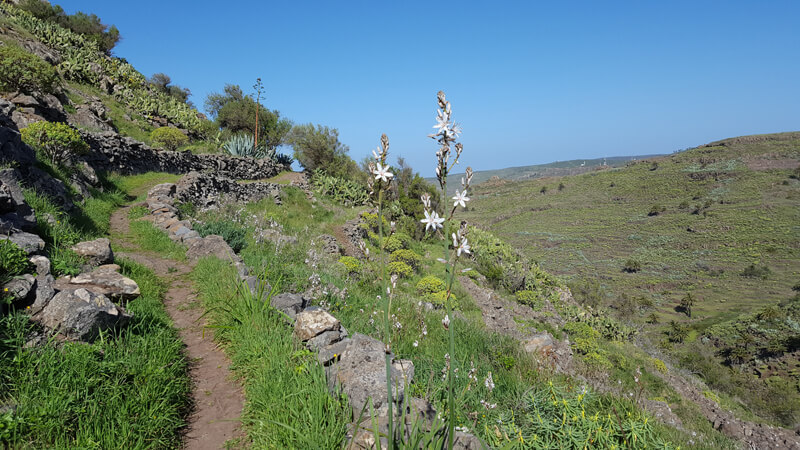 The island’s flora is a delight, even for a botanical atheist. The Garajonay separates the vegetation and climate: you’ll find lush greenery in the north, including ubiquitous euphorbia, 8 foot high dandelion trees – vibrant yellow cousins of the daisy family and only found in the Canaries – towering above you, marguerites, convulvulus, and an unexpected poinsettia tree. The sunny south hosts aromatic shrubs and succulents – cacti, aloe vera and architectural agave plants.
The island’s flora is a delight, even for a botanical atheist. The Garajonay separates the vegetation and climate: you’ll find lush greenery in the north, including ubiquitous euphorbia, 8 foot high dandelion trees – vibrant yellow cousins of the daisy family and only found in the Canaries – towering above you, marguerites, convulvulus, and an unexpected poinsettia tree. The sunny south hosts aromatic shrubs and succulents – cacti, aloe vera and architectural agave plants.
Walking gives you the opportunity to get under the canopy of this botanical paradise, often accompanied only by butterflies, birdsong, and the distant hum of a chainsaw on the far side of a barranco. The island has clearly invested decent amounts in attracting hikers – the paths, however steep and remote, are meticulously maintained. The waymarkers are abundant and precise.
The Macs Adventure route criss-crosses La Gomera to give a perfect insight into its unique landscape, but with options to personalise the itinerary.
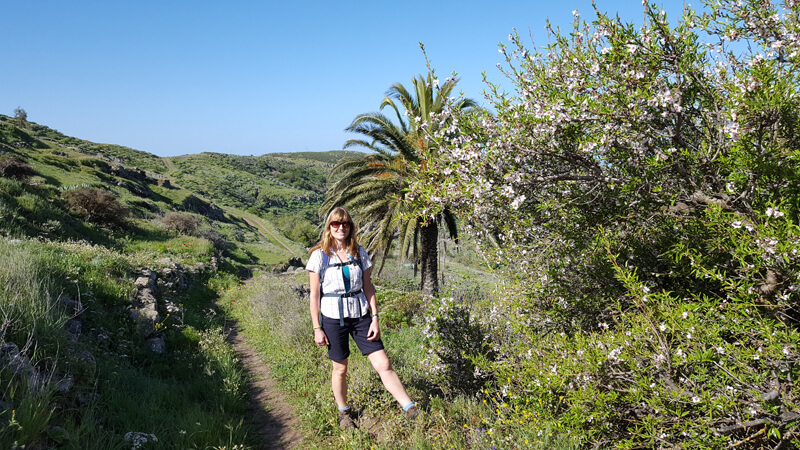 Gill wanted to go back to Valle Gran Rey, so we booked an extra night in Chipude. On a perfect sunlit day we enjoyed a memorable bonus walk, down a flower-lined terraced valley away from the village before climbing up over a saddle and dropping steeply down a gravelly path into the most picturesque barranco on the island. We ate calamari and a freshly caught local alfonsino fish (red bream) at an unpretentious restaurant, a black pebble’s throw from the beach, before catching a bus back into the mountains.
Gill wanted to go back to Valle Gran Rey, so we booked an extra night in Chipude. On a perfect sunlit day we enjoyed a memorable bonus walk, down a flower-lined terraced valley away from the village before climbing up over a saddle and dropping steeply down a gravelly path into the most picturesque barranco on the island. We ate calamari and a freshly caught local alfonsino fish (red bream) at an unpretentious restaurant, a black pebble’s throw from the beach, before catching a bus back into the mountains.
La Gomera is a revelation, and a world away from other more touristy Canary Islands. Explore it on foot if you can, although you’ll need a decent level of fitness to cope with its challenging natural contours. But you won’t find Placido and his wine bar if you don’t get those walking boots on.


